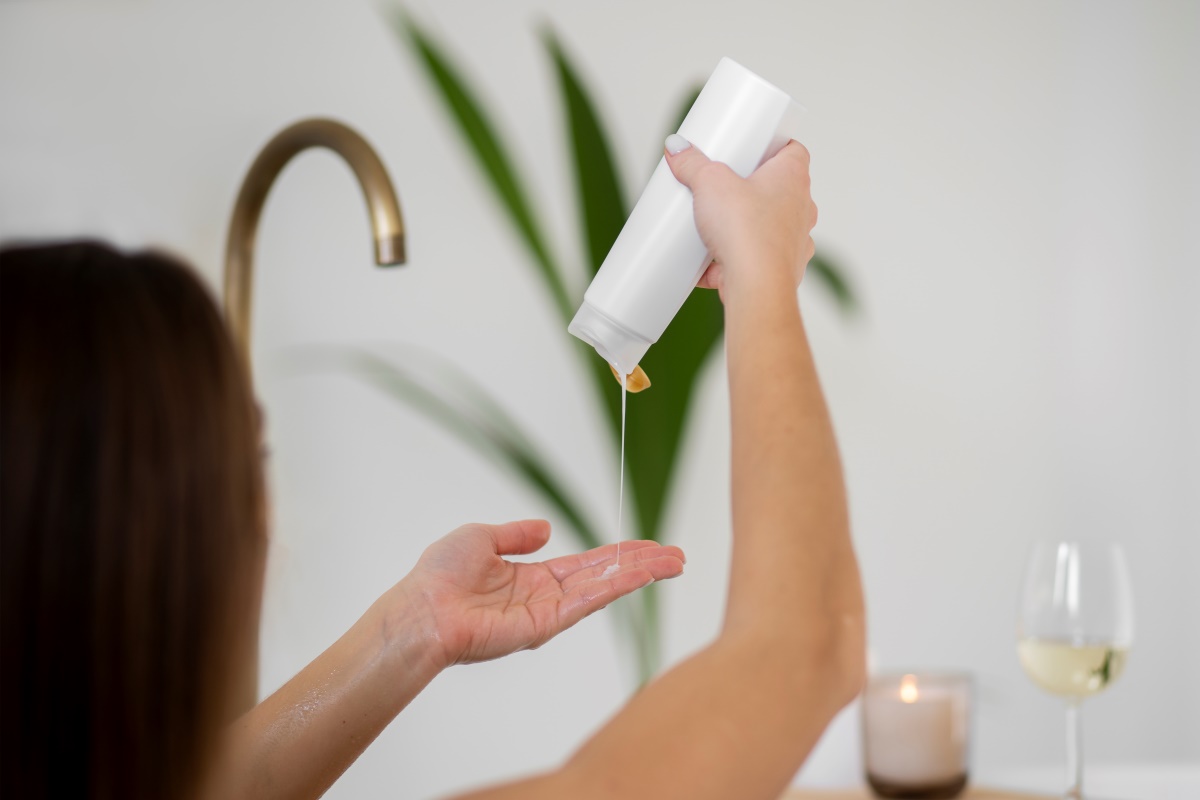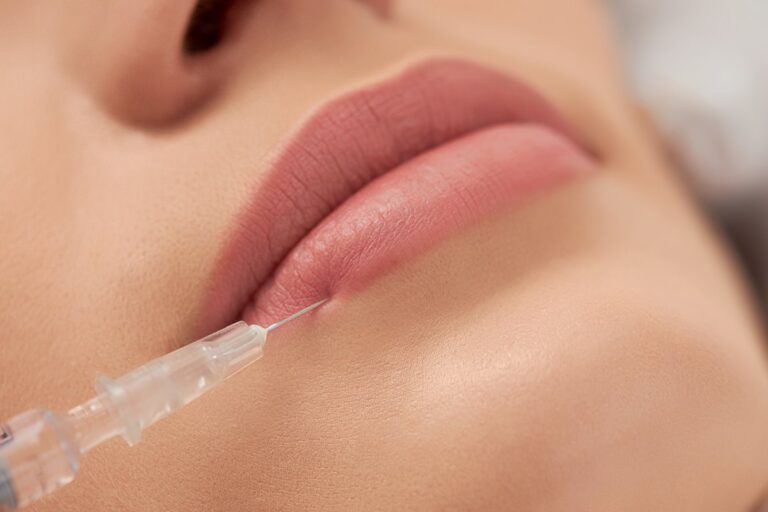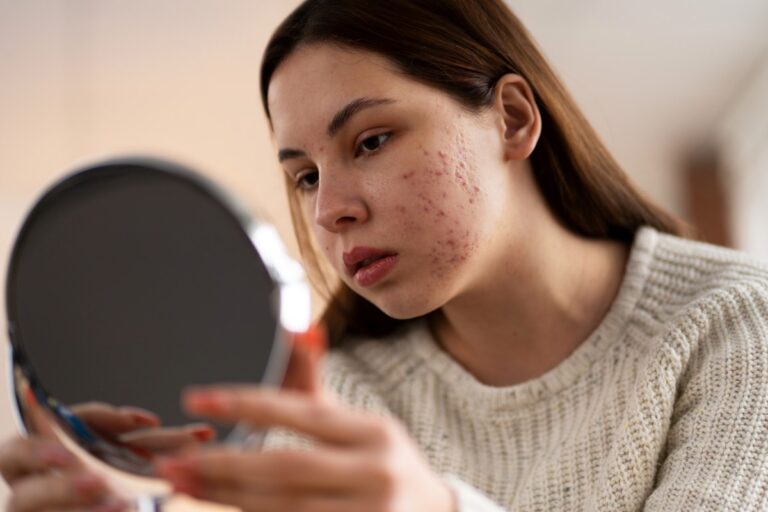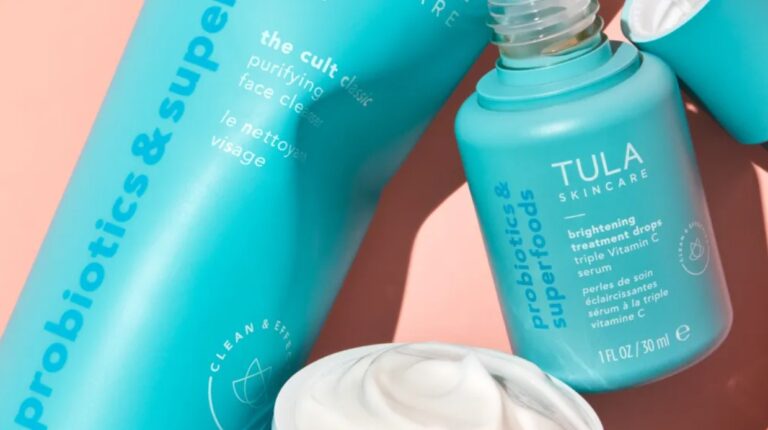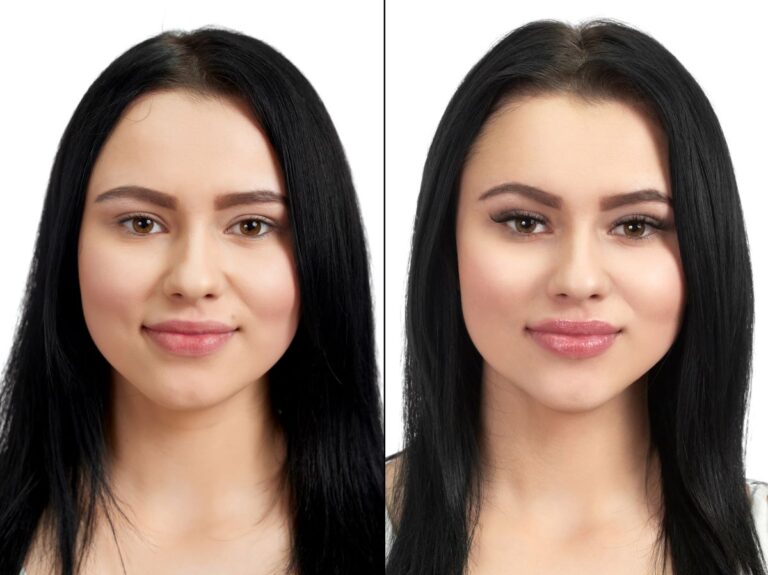What Is Shower Gel: Complete Guide, Secrets, and 10 Main Benefits
Shower gel has become a staple in modern skincare routines, offering a luxurious and refreshing way to cleanse the body. But what is shower gel, and how does it differ from other body cleansers like soap or body wash? In this guide, we’ll explore everything you need to know about shower gel—from its ingredients and benefits to tips on how to choose the best one for your skin type.
Whether you’re new to shower gels or looking to upgrade your shower experience, this comprehensive guide will help you understand why this product deserves a spot in your daily routine.
What Is Shower Gel: The History of Creating
The history of personal cleansing products dates back thousands of years, with the origins of shower gel being a relatively recent development in this long timeline. The concept of using substances to clean the body began in ancient civilizations, where people used various natural ingredients like oils, clay, and herbs to maintain hygiene.
Ancient Egyptians, for example, were known to use a blend of animal fats and alkaline salts to create a rudimentary form of soap, which was used for both personal care and treating skin ailments.
As time progressed, the art of soap-making evolved significantly. By the Middle Ages, soap became more refined, with the introduction of aromatic oils and more sophisticated production techniques. However, it wasn’t until the 19th century that soap as we know it began to take shape. The industrial revolution brought about mass production and commercialization of soap, making it widely accessible and affordable for the general public.
Shower gel, as a distinct product, emerged much later in the 20th century. The shift from traditional bar soaps to liquid cleansers began in the mid-1900s, driven by the demand for more convenient and hygienic options. Liquid soaps gained popularity due to their ease of use and the perception that they were less likely to harbor bacteria compared to bar soaps.
This period also saw significant advancements in chemical engineering, which allowed for the development of milder, more skin-friendly surfactants—key ingredients in both liquid soap and shower gel.
The first true shower gels appeared in the 1970s, designed as a luxurious alternative to soap bars. These early formulations were often marketed as a more sophisticated option, blending cleansing agents with moisturizing ingredients and fragrances to enhance the bathing experience. Unlike traditional soaps, which could be harsh and drying, shower gels offered a gentler cleanse, leaving the skin feeling soft and refreshed.
The popularity of shower gels grew rapidly as they became associated with modernity, luxury, and self-care. Manufacturers began experimenting with different formulations, adding vitamins, essential oils, and various natural extracts to cater to a wide range of skin types and preferences. The 1980s and 1990s saw an explosion of creativity in the market, with brands introducing a variety of scents, textures, and packaging designs to appeal to diverse consumer tastes.
Today, shower gels are a ubiquitous part of daily hygiene routines, available in countless varieties to suit every need and preference. From moisturizing formulas for dry skin to invigorating scents for an energizing start to the day, the evolution of shower gel reflects the broader trends in personal care—where convenience, customization, and skin health are paramount.
As the industry continues to innovate, the history of shower gel serves as a testament to how far we’ve come in our quest for cleanliness and self-care.
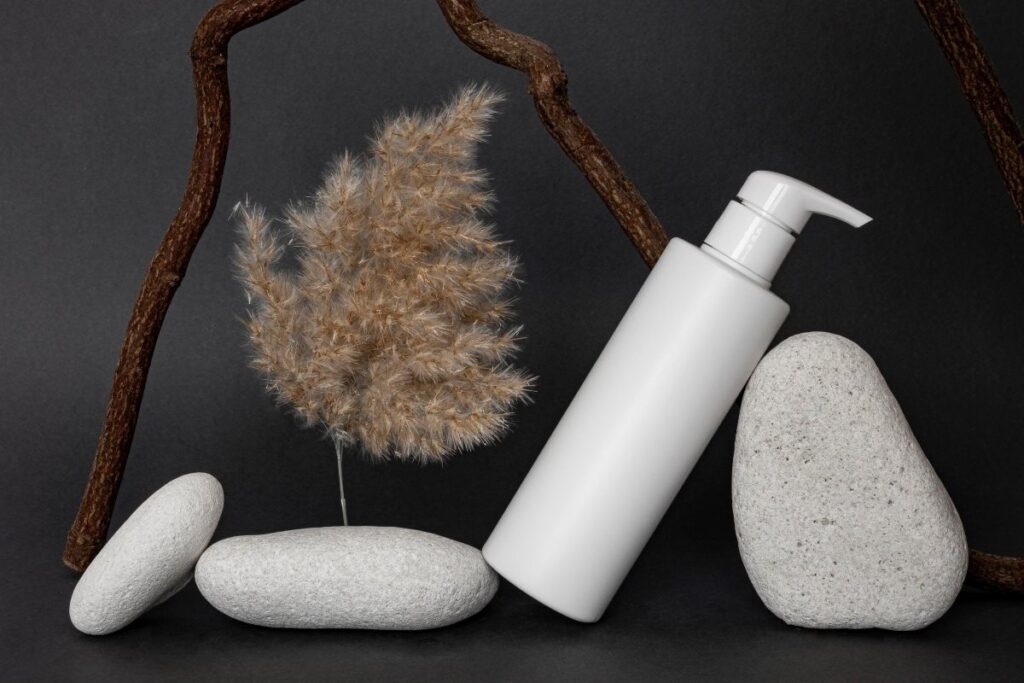
8 Essential Components in Shower Gel
When selecting a shower gel, it’s essential to understand what is shower gel and the key components that contribute to its effectiveness and overall quality. The ingredients in a shower gel not only determine how well it cleanses your skin but also affect its moisturizing properties, fragrance, and how it feels during use. Here’s a breakdown of the most important components to consider when choosing a shower gel:
1. Surfactants
What is shower gel surfactants? They are the primary cleansing agents in shower gels. They work by breaking down oils and dirt on the skin, allowing them to be rinsed away with water. Common surfactants include Sodium Lauryl Sulfate (SLS) and Sodium Laureth Sulfate (SLES), which are effective but can be harsh on sensitive skin.
Gentler alternatives like cocamidopropyl betaine, derived from coconut oil, are increasingly popular for their mildness and skin-friendly properties. The type and concentration of surfactants in a shower gel will largely determine how well it cleanses and whether it leaves the skin feeling soft or stripped of its natural oils.
2. Moisturizers and Humectants
To prevent the skin from drying out during cleansing, many shower gels include moisturizing ingredients. Humectants like glycerin and hyaluronic acid attract and retain moisture, helping to keep the skin hydrated. Emollients such as shea butter, aloe vera, and natural oils (like jojoba or coconut oil) are also common additions, providing a protective barrier that locks in moisture and leaves the skin feeling smooth and supple.
These ingredients are particularly important if you have dry or sensitive skin, as they help counteract the drying effects of surfactants.
3. Fragrance
So what is shower gel fragrance? It is a significant component of shower gels, as it enhances the sensory experience of using the product. Shower gels may contain synthetic fragrances or natural essential oils to create a pleasant aroma. While fragrance adds to the appeal of a shower gel, it can also be a source of irritation for those with sensitive skin or allergies.
For individuals prone to irritation, opting for fragrance-free or naturally scented products might be the best choice. Additionally, the type of fragrance can influence your mood—citrus scents are invigorating, while lavender or chamomile can have a calming effect.
4. Preservatives
Preservatives are necessary to prevent the growth of bacteria, mold, and yeast in shower gels, especially since they are used in a humid environment like the shower. Common preservatives include parabens, phenoxyethanol, and benzyl alcohol.
While these ingredients help maintain the product’s shelf life and safety, there has been some controversy surrounding certain preservatives like parabens, which have been scrutinized for potential health risks. As a result, many brands are now formulating shower gels with alternative, more natural preservatives, or even offering preservative-free options.
5. Thickeners and Stabilizers
To achieve the desired consistency and stability, shower gels often include thickeners and stabilizers. Ingredients like xanthan gum, carrageenan, and carbomers are used to give shower gels their gel-like texture and prevent the ingredients from separating over time.
These components ensure that the product dispenses smoothly and evenly, providing a consistent experience with each use. Additionally, thickeners can also affect the lathering properties of the shower gel, which many users associate with a more luxurious and satisfying cleanse.
6. pH Adjusters
What is shower gel pH level? It is crucial for maintaining the skin’s natural balance. The skin’s surface is slightly acidic, with a pH around 4.5 to 5.5, which helps protect against harmful bacteria and maintain its barrier function.
Shower gels should ideally have a pH that is close to this range to avoid disrupting the skin’s natural acidity, which could lead to dryness, irritation, or breakouts. Common pH adjusters include citric acid and sodium hydroxide, which help ensure the shower gel is compatible with your skin.
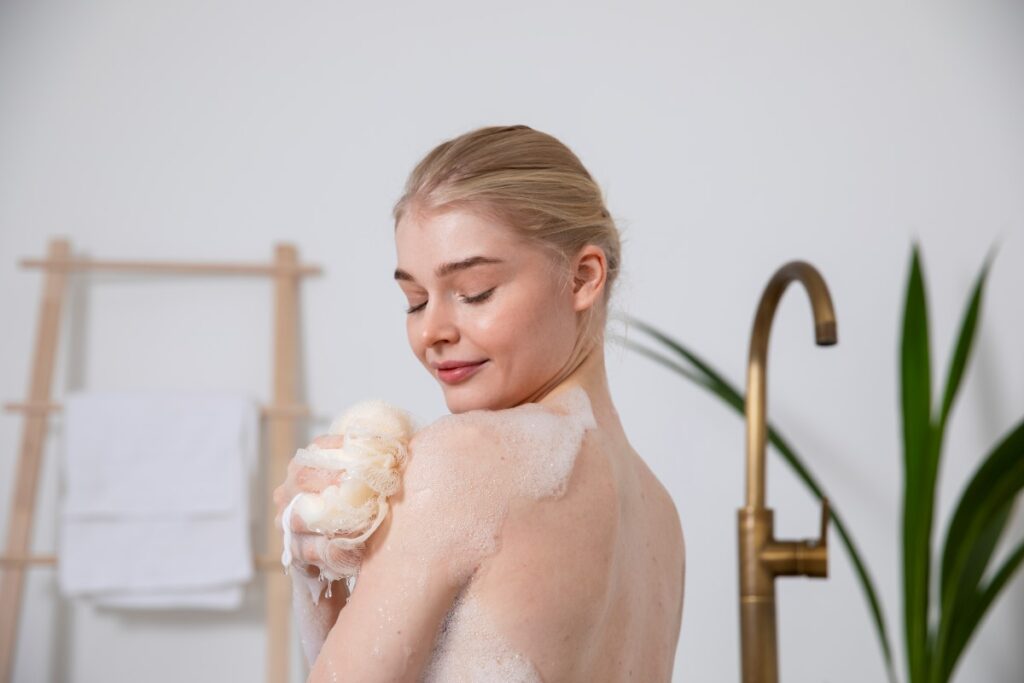
7. Colorants
Colorants are often added to shower gels to enhance their visual appeal, giving them vibrant hues that make the product more attractive to consumers. While these colorants are usually safe and approved for use in cosmetics, they can sometimes cause irritation or allergic reactions, particularly in sensitive individuals. For those with skin sensitivities, opting for shower gels without artificial colorants or those colored with natural ingredients may be a better choice.
8. Special Additives
Many modern shower gels include special additives aimed at providing additional benefits beyond basic cleansing. These can include exfoliants like microbeads (though many are now banned due to environmental concerns), natural scrubbing agents like ground apricot kernels or jojoba beads, and ingredients with purported skin benefits, such as antioxidants, vitamins, and anti-inflammatory agents.
These additives can enhance the shower gel’s functionality, turning it into a multi-purpose product that not only cleanses but also exfoliates, nourishes, or soothes the skin.
How to Choose the Best Shower Gel for Your Skin Type?
What is shower gel best for your skin? Selecting the right shower gel can make a significant difference in your skincare routine, transforming a basic shower into a luxurious, nourishing experience. However, with so many options available, it can be overwhelming to find the perfect match for your skin type and personal preferences. Here’s a detailed guide to help you choose the best shower gel for your needs.
1. Understand Your Skin Type
Your skin type is the most crucial factor in choosing a shower gel. Different formulations cater to specific skin needs, so identifying your skin type will help narrow down your options.
- Dry Skin: Look for moisturizing shower gels that contain humectants like glycerin and hyaluronic acid, as well as emollients like shea butter, aloe vera, or natural oils. Avoid products with harsh surfactants like SLS, which can strip your skin of its natural oils.
- Oily Skin: Choose a shower gel with oil-controlling ingredients, such as tea tree oil or salicylic acid, which help regulate excess sebum without over-drying your skin. A gel with a lightweight, non-greasy formula is ideal for keeping your skin balanced.
- Sensitive Skin: Opt for fragrance-free or hypoallergenic shower gels with soothing ingredients like chamomile, oat extract, or aloe vera. Avoid products with artificial dyes, strong fragrances, or alcohol, as these can irritate sensitive skin.
- Normal/Combination Skin: If you have normal or combination skin, you have the flexibility to experiment with a variety of shower gels. Look for products that provide a balanced cleanse without being too drying or too oily.
2. Consider the Ingredients
So what is shower gel ingredients to consider? The ingredients in your shower gel play a vital role in how well it cleanses and cares for your skin. Here are some key ingredients to consider:
- Surfactants: These are the cleansing agents in shower gels. While Sodium Lauryl Sulfate (SLS) is effective, it can be too harsh for some. Consider gentler surfactants like cocamidopropyl betaine, especially if you have sensitive or dry skin.
- Moisturizers: If hydration is a priority, look for ingredients like glycerin, aloe vera, and natural oils. These help retain moisture and prevent your skin from feeling tight or dry after showering.
- Exfoliants: Some shower gels contain exfoliating agents like beads, ground apricot kernels, or chemical exfoliants like salicylic acid. These are great for removing dead skin cells, but they should be used with caution if you have sensitive skin.
- Fragrance: While a pleasant scent can enhance your shower experience, synthetic fragrances can irritate sensitive skin. If you’re prone to irritation, consider fragrance-free options or those scented with natural essential oils.
- pH Balance: Your skin’s natural pH is slightly acidic, around 4.5 to 5.5. Choose a shower gel with a pH close to this range to maintain the skin’s protective barrier and avoid irritation.
3. Decide on the Fragrance
Fragrance is a key factor in choosing a shower gel, as it can significantly impact your mood and overall experience. Here’s how to pick the right one:
- Citrus and Fruity Scents: These are invigorating and refreshing, making them ideal for morning showers or a quick pick-me-up during the day.
- Floral and Herbal Scents: These can be soothing and calming, perfect for evening showers or when you need to relax.
- Unscented or Mild Scents: If you have sensitive skin or prefer not to have lingering fragrances, opt for unscented or lightly scented shower gels.
Remember that while fragrance can be enjoyable, it’s important to choose a product that aligns with your skin’s needs, especially if you have sensitivities.
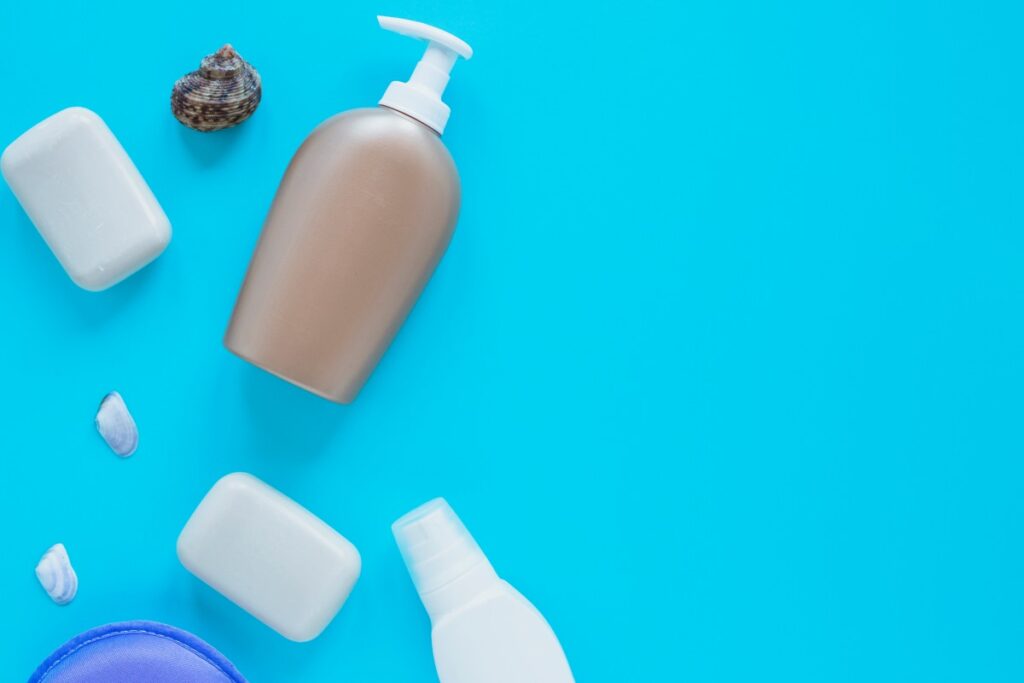
4. Consider Environmental and Ethical Factors
As consumers become more conscious of the environmental impact of their choices, the demand for eco-friendly and ethical products has risen. When choosing a shower gel, consider the following:
- Packaging: Look for brands that use recyclable, biodegradable, or minimal packaging. Some companies offer refillable options to reduce plastic waste.
- Ingredients: Choose shower gels made with natural, sustainably sourced ingredients. Avoid products with microbeads, which are harmful to marine life, and look for certifications indicating that the product is cruelty-free or vegan.
- Brand Ethics: Support brands that prioritize ethical practices, such as fair trade sourcing, cruelty-free testing, and environmental sustainability. Many brands are now transparent about their production processes and ingredient sourcing.
5. Test Before You Commit
If possible, test the shower gel before committing to a full-size purchase. Many brands offer travel-size or sample versions, allowing you to try the product without a significant investment. Pay attention to how your skin feels after use—whether it’s hydrated, soft, and comfortable, or if you notice any irritation or dryness.
6. Read Reviews and Recommendations
Reading reviews about what is shower gel and seeking recommendations from friends, family, or online communities can provide valuable insights into how a shower gel performs. Pay attention to reviews from people with a similar skin type to yours, as their experiences may be more relevant to your needs.
7. Budget Considerations
What is shower gel budget considerations? Shower gels are available in a wide range of prices, from budget-friendly drugstore options to high-end luxury brands. While it’s tempting to splurge on a luxurious shower gel, there are many affordable options that perform just as well. Determine your budget and look for products that offer the best value for money, considering both the quality of ingredients and the size of the bottle.
How to Use Shower Gel: 9 Steps Guide
Using shower gel may seem straightforward, but to get the most out of your product and ensure your skin is left clean, hydrated, and refreshed, there are some best practices to follow. Whether you’re a shower gel novice or simply looking to improve your routine, this guide will walk you through the steps for an optimal shower experience.
1. Choose the Right Tools
Before you start, it’s important to have the right tools on hand to enhance the effectiveness of your shower gel.
- Loofah or Shower Pouf: These tools are great for creating a rich lather and gently exfoliating the skin. A loofah’s textured surface helps to slough away dead skin cells while distributing the shower gel evenly across your body.
- Washcloth: If you prefer a softer option, a washcloth is a good alternative. It provides gentle exfoliation and is easy to clean.
- Hands: In the absence of any tools, using your hands is perfectly fine. They can effectively lather the shower gel, though you may not get the same level of exfoliation as with a loofah or washcloth.
2. Wet Your Skin
Start by thoroughly wetting your body with warm water. The warmth helps to open up your pores, making it easier for the shower gel to cleanse deeply and remove dirt and impurities. Warm water also helps the shower gel lather more effectively, enhancing its cleansing power.
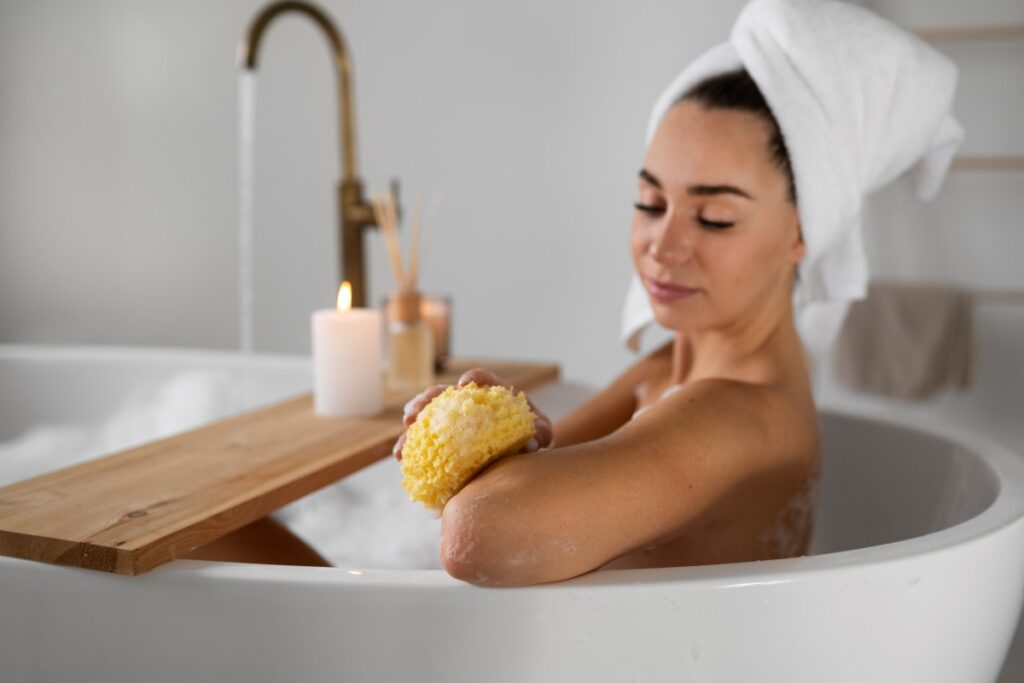
3. Apply the Shower Gel
Squeeze a small amount of shower gel—about the size of a quarter—onto your chosen tool (loofah, pouf, or washcloth) or directly into your hands. A little goes a long way, as most shower gels are concentrated and designed to lather up quickly. If using a loofah or pouf, gently rub it between your hands to create a rich lather before applying it to your body.
4. Lather and Massage
Starting from your neck or shoulders, work your way down your body, using circular motions to massage the lather into your skin. Pay extra attention to areas that tend to accumulate more sweat and oil, such as your underarms, back, and feet. The circular motions help stimulate circulation and ensure that the shower gel cleanses effectively.
- For exfoliation: If you’re using a loofah or pouf, apply slightly more pressure in areas where you want to exfoliate, like your elbows, knees, and heels. This helps remove dead skin cells and leaves your skin smoother.
- Avoid sensitive areas: Be mindful to avoid applying shower gel directly to sensitive areas like your face, which may require a more gentle body cleanser designed specifically for facial skin.
5. Rinse Thoroughly
Once you’ve lathered and massaged the shower gel over your entire body, it’s time to rinse. Use warm water to thoroughly wash away all the soap and lather from your skin. Make sure no residue remains, as leftover shower gel can dry out your skin or cause irritation.
- Cool rinse: For an added boost, you can finish with a quick rinse of cooler water to help close your pores and leave your skin feeling refreshed and invigorated.
6. Dry Off Gently
After rinsing, gently pat your skin dry with a clean, soft towel. Avoid rubbing your skin too harshly, as this can cause irritation or dryness, especially if you have sensitive or delicate skin. Patting helps retain some of the moisture in your skin, leaving it softer and more hydrated.
7. Moisturize Immediately
To lock in moisture and keep your skin feeling soft and smooth, apply a body lotion or moisturizer immediately after drying off. This step is especially important if you have dry or sensitive skin, as it helps to replenish the skin’s natural oils that may have been washed away during your shower.
8. Clean and Maintain Your Shower Tools
Properly maintaining your shower tools is crucial for hygiene and the longevity of your items. After each use:
- Rinse the loofah or pouf: Make sure to rinse out all the soap and squeeze out excess water. Hang it up in a dry, well-ventilated area to prevent the growth of mold and bacteria.
- Wash the washcloth: If you’re using a washcloth, make sure to wash it after each use. Washcloths should be laundered frequently to avoid bacterial buildup.
- Replace regularly: Loofahs and poufs should be replaced every 3-4 weeks, while washcloths can be replaced as needed, depending on wear and tear.
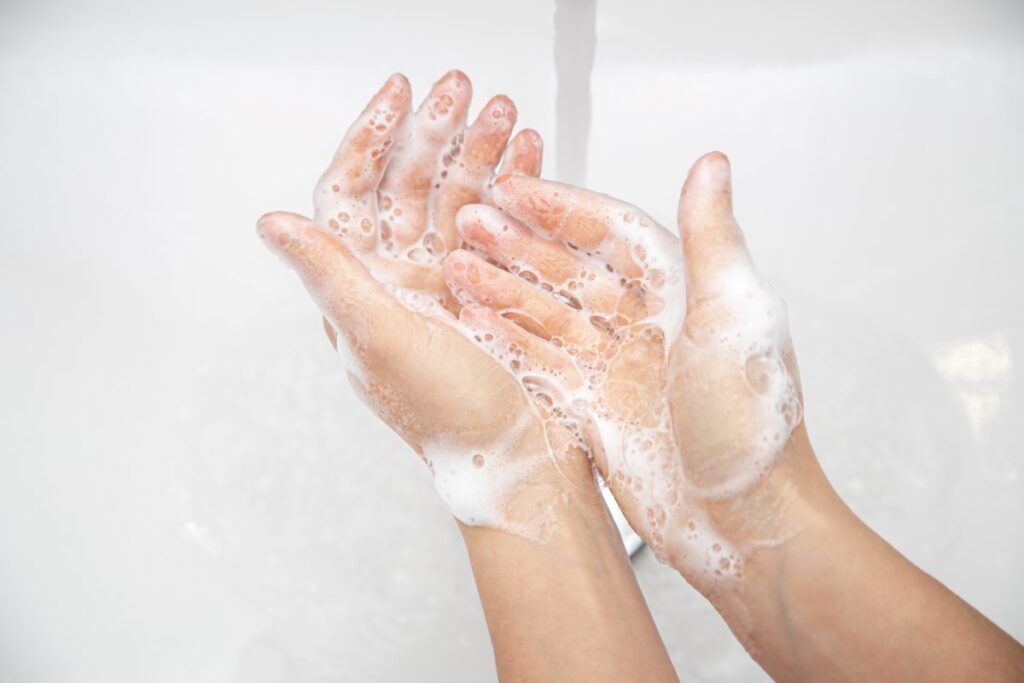
9. Customize Your Routine
Depending on your skin type and needs, you can customize how often you use shower gel. For instance:
- Daily Use: For normal or oily skin, using shower gel daily is generally fine. Just make sure to choose a formula that is gentle and hydrating.
- Every Other Day: If you have very dry or sensitive skin, consider using shower gel every other day and alternating with a moisturizing body wash or simply rinsing with water on non-gel days.
- Targeted Use: You can also use shower gel selectively on areas that need more attention, such as your underarms, feet, or any areas prone to sweating.
What Is Shower Gel: Unlock 10 Main Benefits
Shower gel has become a popular choice for daily cleansing, offering a range of benefits that go beyond simply washing away dirt and sweat. Formulated with a variety of skin-nourishing ingredients, shower gels can enhance your skincare routine, leaving your skin not only clean but also refreshed, hydrated, and healthy. Here’s a detailed look at the benefits of using shower gel on your skin.
✅ Gentle and Effective Cleansing
So what is shower gel effective cleansing? One of the primary benefits of shower gel is its ability to cleanse the skin thoroughly while being gentle. Unlike some bar soaps that can be harsh and drying, many shower gels are formulated with milder surfactants that effectively remove dirt, oil, and impurities without stripping the skin of its natural moisture. This gentle cleansing action makes shower gel suitable for all skin types, including sensitive and dry skin.
✅ Hydration and Moisturization
Many shower gels are enriched with moisturizing ingredients like glycerin, aloe vera, shea butter, and various natural oils that help to hydrate the skin during the cleansing process. These ingredients attract and lock in moisture, ensuring that your skin remains soft, supple, and well-hydrated even after rinsing. This is particularly beneficial for people with dry skin, as it helps to prevent the tightness and discomfort that can result from washing with harsher products.
✅ Customized Skincare
What is shower gel customized skincare? Shower gels come in a wide range of formulations designed to address specific skin concerns. Whether you need a product that soothes sensitive skin, controls excess oil, or exfoliates to remove dead skin cells, there’s a shower gel tailored to your needs. For example:
- Exfoliating Shower Gels: These contain gentle exfoliants like jojoba beads or salicylic acid that help slough off dead skin cells, promoting smoother, more radiant skin.
- Soothing Shower Gels: Formulated with calming ingredients like chamomile, oatmeal, or aloe vera, these gels are ideal for sensitive or irritated skin, helping to reduce redness and inflammation.
- Balancing Shower Gels: Designed for oily or acne-prone skin, these gels often contain ingredients like tea tree oil or salicylic acid to help regulate sebum production and prevent breakouts.
✅ Refreshing and Invigorating
The variety of fragrances available in shower gels can have an immediate impact on your mood and overall well-being. Whether you prefer energizing citrus scents, calming lavender, or refreshing mint, the right shower gel can turn your shower into a sensory experience. Aromatherapy benefits from essential oils or natural fragrances can help to invigorate you in the morning or relax you before bed, making your shower a time to reset both body and mind.
✅ Maintaining the Skin’s Natural pH Balance
The pH of healthy skin is slightly acidic, usually between 4.5 and 5.5, which is essential to its barrier function and defense against dangerous microorganisms and environmental contaminants. A lot of shower gels are made to be pH-balanced, which means they are made to balance out or enhance the natural acidity of your skin. By using a pH-balanced shower gel, you may prevent problems like dryness, irritation, and sensitivity that can occur from using products with an incorrect pH level. You can also help preserve the skin’s protective barrier.
✅ Convenience and Hygienic Packaging
Shower gels are typically packaged in bottles or pumps, making them more hygienic than bar soaps, which can collect bacteria when left in a damp environment. The liquid form of shower gel is easy to dispense, control, and apply, allowing for a quick and convenient shower routine. Additionally, the packaging helps minimize mess and waste, as you can use just the right amount of product without it slipping away like a bar of soap might.
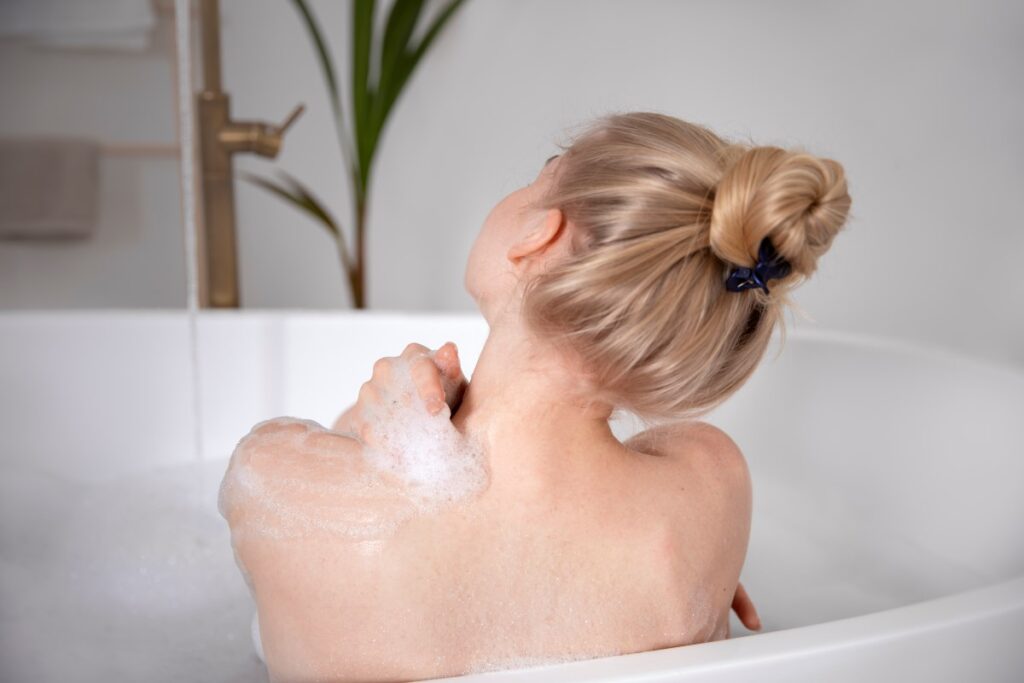
✅ Enhancing Skin Texture
So what is shower gel enhancing skin texture? Shower gels frequently include substances that not only clean your skin but also make it look better. For example, by removing dead skin cells, exfoliating shower gels can help smooth out rough regions, while moisturizing compositions can leave the skin feeling smooth and soft. Regular use of a shower gel appropriate for your skin type might eventually result in a discernible improvement in the texture of your skin, giving it a more vibrant and healthy appearance.
✅ Anti-Aging and Skin Protection
Many shower gels are now formulated with ingredients that offer additional skin benefits, such as antioxidants, vitamins, and anti-aging compounds. Antioxidants like vitamin C and E help to neutralize free radicals, which are responsible for skin aging and damage. By incorporating these into your daily shower routine, you can help protect your skin from premature aging, environmental stressors, and maintain a youthful appearance.
✅ A Multi-Functional Product
Shower gels often serve multiple purposes, depending on their formulation. Some shower gels can double as a bubble bath, offering a luxurious soak with added skin benefits. Others may be designed to be gentle enough for use on both the body and face, providing an all-in-one solution for your shower needs. This versatility makes shower gel a convenient and efficient option for those looking to streamline their skincare routine without sacrificing results.
✅ Ideal for All Skin Types
Whether you have dry, oily, sensitive, or combination skin, there’s a shower gel formulated to meet your specific needs. The wide variety of options means you can find a product that not only cleanses effectively but also provides targeted care tailored to your skin type. For those with specific skin concerns—such as eczema or psoriasis—there are shower gels formulated with dermatologically tested ingredients that provide gentle care while addressing these conditions.
Conclusion
What is shower gel? More than a simple cleansing product, shower gel has evolved into an indispensable component of modern self-care. Its versatility shines through its ability to cater to diverse skin needs, from the delicate balance of sensitive skin to the deep cleanse required for oily complexions. Enriched with a spectrum of beneficial ingredients, shower gels not only purify but also nurture the skin, leaving it refreshed, revitalized, and radiant.
Beyond its skincare benefits, shower gel offers a sensory experience. The convenience of its packaging, coupled with a myriad of enticing fragrances, transforms the daily shower into a moment of indulgence. By selecting the right shower gel, individuals can elevate their bathing ritual into a rejuvenating escape that not only cleanses but also replenishes the body and mind.
